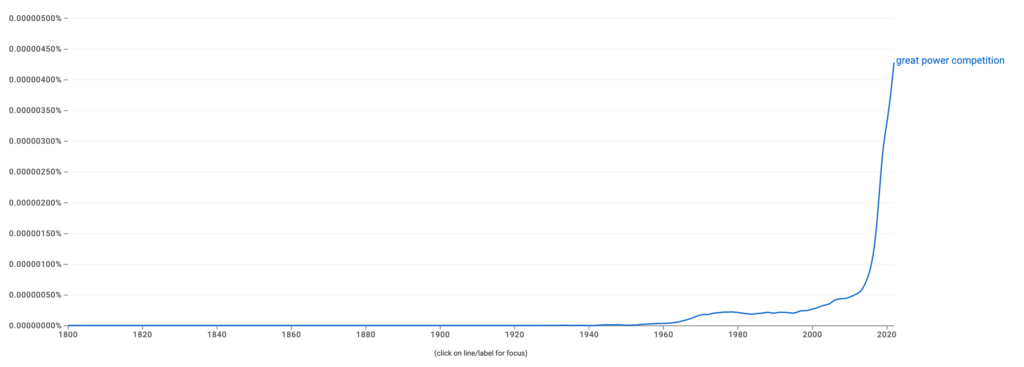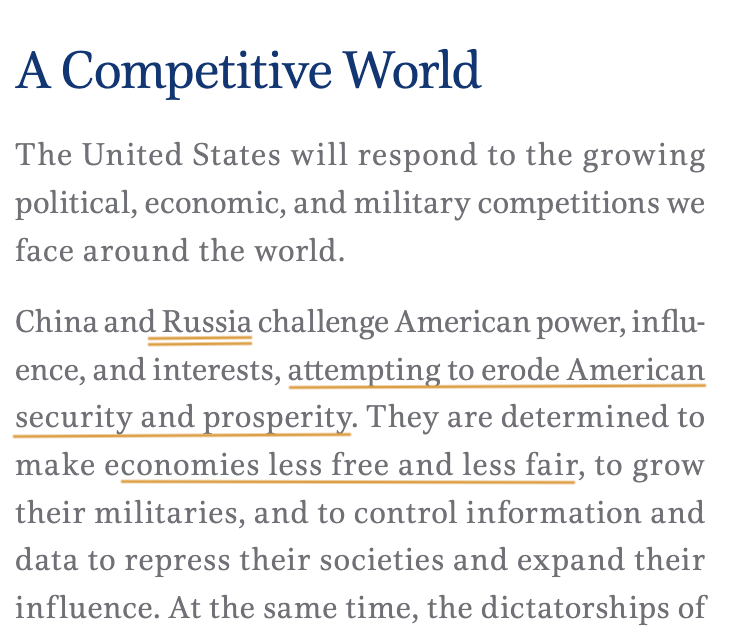Back in March, I wrote a post at Lawyers, Guns and Money called “Remember ‘Great Power Competition?’ Lol.” As the “Grand Strategy” of Trump 2.0 comes into focus, I thought it would be a good idea to revisit and update it.
In brief, the normie national-security advisors who dominated the first Trump administration needed a way to make Trump’s semi-coherent ramblings legible to the global foreign-policy community. That is, to synthesize his half-baked ideas into a “grand strategy” that fit within established frameworks.
Their answer was “Great Power Competition,” especially as articulated in the 2017 U.S. National Security Strategy by its principal author, Nadia Schadlow.
It worked. “GPC” took the national-security and foreign-policy commentariat by storm. The concept figured prominently in academic workshops and grants, think tank events and reports, and policy speeches and articles. It went from zero to shibboleth in record time.

But here’s the weird thing: the concept never made a ton of sense, whether as an analytic framework, a basis for grand strategy, or as a description of Trump grand strategy.
I think it fair to say that most observers interpreted “GPC” as an admission that unipolarity, the era of the United States as the “sole superpower,” was fading fast. Washington now faced a world with multiple great powers — perhaps with the United States and China sitting at the top of the global hierarchy of capabilities.
This ipso facto entailed a fundamentally realist understanding of international politics, and even many of those who weren’t realists themselves read “GPC” as a claim that “realpolitik is back, baby!” Or, if you consider yourself a sophisticate, “machtpolitik is back, fräulein!”
For both realists and “realists,”1 this was obviously great news. Since at least the end of the Cold War, the main axis of conflict in U.S. foreign-policy thought was between two different variants of liberalism: liberal internationalism and neoconservatism. As Paul Musgrave and I wrote back in 2013:
[T] rise of neoconservative foreign-policy principles in their post-Cold War variant scrambled the conventional realist-liberal divide…. Neoconservative foreign policy principles adopt elements of liberal internationalism, such as the importance of liberal values like freedom, democracy, and open markets, to foreign policy decision-making. While many realists decry the tendency of the United States to engage in ideological crusades, neoconservatives, like liberals, argue that Washington should use its influence to enlarge the community of democratic nations. Unlike liberal internationalists, they express intense skepticism about the power of international law, norms, and institutions to restrain power-political competition.
The neoconservative call for the United States to embrace power-maximization strategies, its dismissal of international institutions, and its penchant for unilateralism each reflect realist criticisms of liberal internationalism. These positions, however, do not place them outside the liberal fold. For some neoconservatives, the problem with existing international institutions lies in their illiberalism—specifically, the influence they grant to non-democratic and illiberal regimes. The United States therefore must embrace unilateralism out of necessity: not only does the influence of illiberal regimes hamper effective multilateral responses in institutions such as the United Nations, but democratic allies—whether from corrupt economic entanglements, a lack of commitment to liberal principles, or willful ignorance—sometimes fail to recognize the threat posed by the enemies of liberal order.
Realists dislike liberal internationalism, which they view as hopelessly naïve. Most realists actively despise neoconservatism, which they believe embodies the worst impulses of liberal internationalism.2
The 2017 NSS does include what I’ve called the “Thirty Years Crisis” diagnoses of the “unipolar era.” E.H. Carr arguedthat the interwar period was a “Twenty Years Crisis” in which “utopians” put their faith in the “universal” desirability of democracy, peace, and market capitalism. This left them unable to respond properly to the rise of dissatisfied powers, such Fascist Italy, Kokkashugi-era Japan, and Nazi Germany.
For opponents of liberal foreign policy, the United States made the same mistake in the 1990s and 2000s, when it ‘squandered’ its power-political advantages while actively assisting the rise of rival powers, most notably China.
As the NSS puts it:
Following the remarkable victory of free nations in the Cold War, America emerged as the lone superpower with enormous advantages and momentum in the world. Success, however, bred complacency. A belief emerged, among many, that American power would be unchallenged and self-sustaining. The United States began to drift. We experienced a crisis of confidence and surrendered our advantages in key areas. As we took our political, economic, and military advantages for granted, other actors steadily implemented their long-term plans to challenge America and to advance agendas opposed to the United States, our allies, and our partners.
We stood by while countries exploited the international institutions we helped to build. They subsidized their industries, forced technology transfers, and distorted markets. These and other actions challenged America’s economic security. At home, excessive regulations and high taxes stifled growth and weakened free enterprise—history’s greatest antidote to poverty. Each time government encroached on the productive activities of private commerce, it threatened not only our prosperity but also the spirit of creation and innovation that has been key to our national greatness.
This is, of course, already an uncomfortable fusion of traditional free-market conservatism (i.e., market liberalism) and Trump’s own preference for mercantilism. We find something similar in the next section, which reads as a strange mashup of “GPC” with boilerplate U.S. foreign-policy exceptionalism.

What made “Great Power Competition” plausible as an organizing theme of Trump foreign policy? The fact that Trump left the national-security bureaucracy pretty much alone. Trump appointments at the Department of Defense, the National Security Council, and other key institutions pretty much did their own thing.
Trump might make noise about abandoning NATO or visibly show deference to Putin at Helsinki. But the United States was, as Trump officials assured their counterparts in Europe, also increasing its military support to NATO and providing lethal aid to Ukraine.
Trump might threaten to pull military bases from Korea unless Seoul provided greater “compensation” to the United States, but, Trump officials could argue, he was also the first president to truly understand the China threat. Surely he would never actually abandon key U.S. allies in the region? Look at how happy he was to sellTaiwan practically any weapons-system that it wanted.
Many Republican hawks even found ways to accommodate themselves to Trump’s wobbliness on NATO. China was the true threat, after all. Europe can defend itself, no? Nixon went to China. Maybe Trump can go to Moscow and convince Putin to turn on one of his closest strategic partners—never mind that the actual causes of the Sino-Soviet split, or the fact that it happened more than a decade before the U.S. formed a strategic partnership with Beijing.
In his second term, Trump has thrown all of this out. The handful of GPC types who remain in positions of influence — such as Marco Rubio and Elbridge Colby — have accommodated themselves to the new order. Now, “great-power competition” with China begins and ends with tariffs.
As I wrote in the original version of this post, no administration truly committed to great-power competition, let alone with China, would, among other things:
- Create a power vacuum for Beijing to fill in arenas such as global public health, international development, and important international organizations;
- Dismantle U.S. state capacity, seek to gut basic research, and freeze all U.S. international anti-corruption efforts;
- Allow a drug-addled narcissist and his junior-league brown shirts to compromise U.S. government computer systems;
- Alienate governments whose cooperation the U.S. desperately needs if it wants to implement effective export-controls on China, let alone those who make important contributions to U.S. intelligence gathering; and
- Threaten to abandon Taiwan while talking about a “grand bargain” with Xi.
In October of 2025, we do not even need to look for indicators. The administration has made clear that its overwhelming strategic priority is defense of the “homeland” against “enemies within,” whether migrants, cartels, or left-wing “terrorists.”
Trump’s own foreign-policy priorities are about status and patronage. I think it is pretty clear that his ideal is a kind of kleptocrat elite-pact with autocratic leaders, in which they help themselves stay in power while they, and supportive oligarchs, maximize the value of the rents that they extract and the foreign bribes that they receive.
Why else cease to enforce anti-corruption laws, especially those aimed at preventing kleptocrats from offshoring and laundering wealth? Why else open the door to Russian cyber operations in the United States — does the world’s greatest deal-maker normally negotiate by throwing an entire crop of carrots at a weaker counter-party?
Back when I wrote the first version of this piece, I noted that some commentators had started to call Trump’s economic plans “shock therapy.” This missed the key part of the analogy: in post-Soviet Russia, “shock therapy” allowed emerging oligarchs to strip the state of its assets in the service of personal enrichment. That’s already happening here; Musk ordered government agencies to purchases his services, while other billionaires have found ways to funnelprotection money to Trump and his allies.
The evidence for graft-based foreign policy continues to mount. Readers almost certainly know about the Boeing 747–800 luxury aircraft that Qatar gifted to Trump. I expect most of you know that the Department of Defense is spending(at least) close to a billion dollars to refurbish it, and that Trump intends to keep it once he leaves office. But I expect that most Americans are unaware of the sheer amount of money that Qatar has thrown at Trumpworld, or has agreed to provide in the form of “wins” for the Trump administration. These efforts to court Trumpworld took off during the Saudi-led boycott of Qatar that began in 2017 and ended in January 2021. Its most recent dividend: Trump’s decree“establishing” U.S. security guarantees for Qatar — although the timing was almost certainly intended to secure Qatar’s backing for the current Gaza peace plan despite Israel’s military strikes in the country.
In September, the New York Times reported on a strange coincidence involving U.S. relations with the UAE:
In May, Mr. Witkoff’s son Zach announced the first of the deals at a conference in Dubai. One of Sheikh Tahnoon’s investment firms would deposit $2 billion into World Liberty Financial, a cryptocurrency start-up founded by the Witkoffs and Trumps.
Two weeks later, the White House agreed to allow the U.A.E. accessto hundreds of thousands of the world’s most advanced and scarce computer chips, a crucial tool in the high-stakes race to dominate artificial intelligence. Many of the chips would go to G42, a sprawling technology firm controlled by Sheikh Tahnoon, despite national security concerns that the chips could be shared with China.
Those negotiations involved another key White House official with ties to the tech industry and to the Middle East: David Sacks. A longtime venture capitalist, Mr. Sacks serves as the administration’s A.I. and crypto czar, a newly created position that has allowed him to shape tech policy even as he continues to work in Silicon Valley.
The Times found that the agreements were intertwined in ways that have not been previously reported and that they provoked concerns about conflicts of interest even from staff members in the Trump administration.
While the usual suspects continue to argue about Trump’s “grand strategy,” scholars of comparative politics seem better equipped to understand the moment. Hansen and Kopstein, for example, write about Trump’s “patrimonial foreign policy.” While I think they’re too quick to slap the label “patrimonial” on behaviors that are more specific to kleptocratic right-wing populists (e.g., “multipolar populists“) in general, and sometimes Trump in particular, their diagnoses is far more correct than not.
None of this means an end to rivalry. Trump is currently running “cold” on Putin — who Trump realizes does not, in fact, care that much about helping him win a Noble Peace Prize. But he is not angry enough, at least for now, to apply a new round of secondary sanctions.
In a forthcoming piece, Abraham Newman and Stacie Goddard argue that the emerging system is best understood as “Neo-Royal,” in that it resembles systems built around “cliques” of dynastic rulers. I’m not sure I love the neologism, but I do think their analysis is pretty spot on.3 The arrangements that they describe involve plenty of competition among rulers, as well as concurrent cooperation and collusion aimed at maintaining their system-level prerogatives and patronage.
What we are not talking about, however, are the kinds of “state interests” that dominate contemporary discussions of foreign policy. Those discussions take for granted that states have, and pursue, consistent “national” priorities. This is only possible in the context of an impersonal bureaucracy that internalizes and transmits stable conceptions of “the public interest.”4
Personalist regimes pursue personalist interests. In the modern era, they invoke “national interests” and “the people” in order to justify their policies. Sometimes personalists interests will track with the “state interests” identified by realist and geopolitical theories. But efforts to make sense of their foreign policies — whether found in academic journals or Foreign Affairs — with reference to those interests are whistling past the graveyard.
1 The latter camp includes the current Undersecretary of Defense for Policy.
2 Some liberal internationalists viewed neoconservatism — and especially the decision to invade Iraq — as fundamentally realist. In my view, the best case we can make for this argument is to view neoconservatism as a kind of unholy hybrid of liberalism with offensive realism.
3 But I’m biased, since it tracks with what I’ve been saying online for quite some time, including in the original version of this post.
4 See not only Hansen and Kopstein, but J.P. Nettl’s classic article, “The State as a Conceptual Variable.”


I appreciate Dan Nexon’s acumen. However, I find the author’s critique of the second Trump administration as lacking strategic coherence to be far more persuasive than the idea that China and the United States are not locked in a technological, military, and geopolitical competition.
Can there be a competition if one side isn’t really trying?